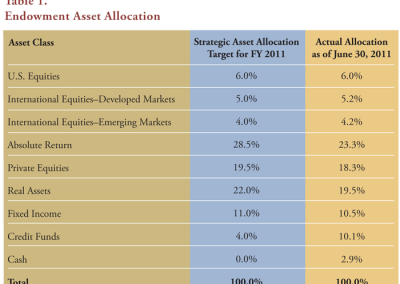The Endowment
Investment Performance
The University of Chicago’s endowment finished fiscal year 2011 with a market value of $6.58 billion, including $884 million of Medical Center endowment. This represented an increase of $909 million from the June 30, 2010, value of $5.67 billion. Ninety-eight percent of the endowment is invested in the Total Return Investment Pool (TRIP). TRIP’s return, net of outside management fees, was +18.8 percent for the fiscal year (see figure 1).
The strong performance was driven by excellent results across a broad spectrum of investments. The University’s portfolio benefited from strong global equity markets over this period; for example, the Russell 3000 Index returned 32.4 percent, and international equities, as represented by the MSCI EAFE Index, were up 30.9 percent. Strong capital markets supported double-digit returns in a variety of alternative investment strategies, including real assets, absolute return, and private equity. The majority of TRIP’s assets are managed by external managers specializing in a specific asset class, geography, or strategy. These asset managers outperformed their respective benchmarks in every asset class, adding over 500 basis points of performance versus the strategic benchmark. The strong performance was generated even as TRIP’s risk exposure to equity markets was reduced throughout the year.
The endowment’s long-term performance is especially important given its dual role of providing support for current operations and for future generations. Between June 30, 2002, and June 30, 2011, with the help of solid investment returns, generous alumni support, and prudent spending, the endowment increased from $3.24 billion to $6.58 billion (see figure 2). During that period, the University of Chicago earned an average annual return of 8.3 percent or 140 basis points ahead of the benchmark, while gifts to endowment totaled $758 million.
Endowment Management and Asset Allocation
The Investment Committee of the Board of Trustees is responsible for overseeing the investment of endowment funds. The committee’s all-volunteer members, most of whom have significant professional experience managing investments, are trustees of the University.
This year the Investment Committee completed a review of the investment strategy for TRIP in the context of a Total Enterprise Asset Management (“TEAM”) approach. The TEAM approach seeks to evaluate the investment strategy as an integrated part of the operating plans of the University rather than in isolation and focuses on the entire enterprise’s success, not just TRIP investment returns. TEAM accomplishes this by understanding the common economic drivers of the University’s financial position and the investment markets, and, from there, analyzing the trade-off between short-term operating risk and long-term wealth accumulation in the enterprise. Informed by this analysis, the committee reviewed TRIP’s asset allocation and risk positioning. The new asset allocation, while maintaining a meaningful exposure to equity-sensitive investments, resulted in slightly less market risk and a focus on improving liquidity.
The endowment is well-diversified among a variety of asset classes, with the investment objective of earning equity-like returns with less volatility over a 10-year period (see table 1). A staff of investment professionals manages the allocations within specific committee-approved ranges. Deviations from the strategic asset allocation are the result of structural factors, such as the difficulty of accessing quality investment opportunities in the private equity and other sectors, or active decisions by staff and the Investment Committee.
In order to meet the return objective, the asset allocation is biased in favor of a broad range of asset classes with equity-like characteristics. To reduce volatility and diversify against adverse equity markets, the endowment also has allocations to high-grade fixed income, real estate, and other real assets.
The Role of the Endowment
The fundamental purpose of the University’s endowed funds is to support the core academic mission of the University by supplying a steady source of income to supplement the operating budget. Currently, the endowment provides approximately 12.3 percent of total revenue.
Spending from the endowment is used primarily for academic purposes, going toward academic programs, instruction and research, faculty salary support, student aid, library acquisitions, and maintenance of the buildings and classrooms.
Maintaining and growing the value of the endowment over time is critical to ensuring that the steady source of income the endowment provides will not be eroded. At the University of Chicago, that is accomplished in a number of ways, including a well-diversified portfolio and a conservative spending policy.
Endowment Spending
The control of endowment spending, a critical factor in maintaining value over time, is a responsibility that is vested in the trustees of the University. Each year as part of the budget process, the trustees are asked to approve a level of spending that is within the range of 4.5 to 5.5 percent of a 12-quarter average market value, lagged one year. The flexibility afforded the trustees by virtue of the range allows them to lower the rate of spending during periods of market appreciation and to increase it during periods of decline. This spending rule, which was implemented with the fiscal year 2005, is designed to strike a healthy balance between long-term asset preservation and prudent spending for current operations. It has the added benefit of cushioning the payout from sudden swings or shocks in the financial markets.


